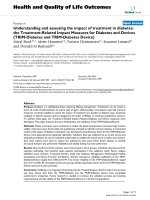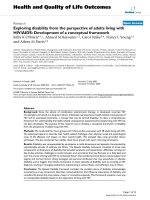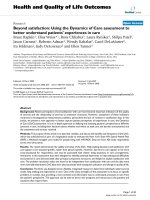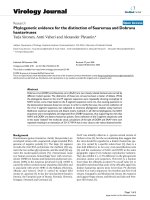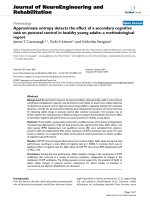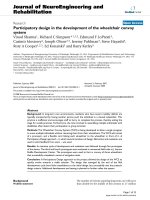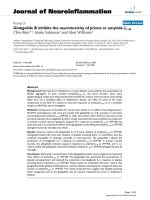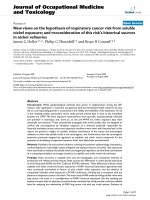báo cáo hóa học:" Minireview: Transaminases for the synthesis of enantiopure beta-amino acids" doc
Bạn đang xem bản rút gọn của tài liệu. Xem và tải ngay bản đầy đủ của tài liệu tại đây (1.46 MB, 38 trang )
This Provisional PDF corresponds to the article as it appeared upon acceptance. Fully formatted
PDF and full text (HTML) versions will be made available soon.
Minireview: Transaminases for the synthesis of enantiopure beta-amino acids
AMB Express 2012, 2:11 doi:10.1186/2191-0855-2-11
Jens Rudat ()
Birgit R Brucher ()
Christoph Syldatk ()
ISSN 2191-0855
Article type Mini-Review
Submission date 20 January 2012
Acceptance date 31 January 2012
Publication date 31 January 2012
Article URL />This peer-reviewed article was published immediately upon acceptance. It can be downloaded,
printed and distributed freely for any purposes (see copyright notice below).
Articles in AMB Express are listed in PubMed and archived at PubMed Central.
For information about publishing your research in AMB Express go to
/>For information about other SpringerOpen publications go to
AMB Express
© 2012 Rudat et al. ; licensee Springer.
This is an open access article distributed under the terms of the Creative Commons Attribution License ( />which permits unrestricted use, distribution, and reproduction in any medium, provided the original work is properly cited.
- 1 -
Minireview: Transaminases for the synthesis of enantiopure beta-amino acids
Authors: Jens Rudat, Birgit R Brucher, Christoph Syldatk
Affiliation: Institute of Process Engineering in Life Sciences, Section II: Technical
Biology, Karlsruhe Institute of Technology (KIT), Engler-Bunte-Ring 1, 76131
Karlsruhe, Germany
Corresponding author:
, Tel.: +49 721 608 48428, Fax: +49
721 608 44881
BRB:
CS:
- 2 -
Abstract
Optically pure β-amino acids constitute interesting building blocks for
peptidomimetics and a great variety of pharmaceutically important compounds. Their
efficient synthesis still poses a major challenge. Transaminases (also known as
aminotransferases) possess a great potential for the synthesis of optically pure β-
amino acids. These pyridoxal 5’-dependent enzymes catalyze the transfer of an
amino group from a donor substrate to an acceptor, thus enabling the synthesis of a
wide variety of chiral amines and amino acids. Transaminases can be applied either
for the kinetic resolution of racemic compounds or the asymmetric synthesis starting
from a prochiral substrate. This review gives an overview over microbial
transaminases with activity towards β-amino acids and their substrate spectra. It also
outlines current strategies for the screening of new biocatalysts. Particular emphasis
is placed on activity assays which are applicable to high-throughput screening.
Keywords: transaminase, beta-amino acid, high-throughput screening, biocatalysis
- 3 -
Introduction
Since the discovery of transamination in biological systems (Braunstein and
Kritzmann 1937; Moyle Needham 1930) the significance of transaminases (TAs) for
amino acid metabolism has been the subject of intensive research. Over the last 15
years, TAs have gained increasing attention in organic synthesis for the biocatalytic
production of a wide variety of chiral amines and α-amino acids. This has been
discussed in detail in a series of excellent reviews (Höhne and Bornscheuer 2009;
Koszelewski et al. 2010; Taylor et al. 1998; Ward and Wohlgemuth 2010).
Advantages in the use of TAs lie in mostly low-cost substrates, no necessity for
external cofactor recycling and the enzymes’ high enantioselectivity and reaction
rate. For the synthesis of enantiopure β-amino acids only a limited number of TAs are
available. Therefore efficient screening techniques for TAs with high activities as well
as broader substrate specificity and different enantioselectivities are crucial for the
successful application of transaminases for the synthesis of β-amino acids. Of
particular interest are methods that can be used at small scale compatible with
microtiter plates.
Enantiopure β-amino acids represent highly valuable building blocks for
peptidomimetics and the synthesis of bioactive compounds. In order to distinguish
positional isomers of β-amino acids, the terms β
2
-, β
3
- and β
2,3
-amino acids have
been introduced by Seebach and coworkers (Hintermann and Seebach 1997;
Seebach et al. 1997). With the exception of β-alanine and β-aminoisobutyric acid
which constitute key intermediates in several metabolic pathways, β-amino acids are
not as abundant in nature as α-amino acids. However, they occur as essential parts
in a variety of biologically active compounds. Notable representatives are the
- 4 -
antineoplastic agent paclitaxel (=Taxol™, Bristol-Myers Squibb) (Wani et al. 1971)
and the chromophore of C-1027 (=lidamycin), a radiomimetic antitumor agent (Hu et
al. 1988) (Fig. 1a). β-Amino acids have drawn much attention as building blocks for
synthetic peptides. They can form oligomers analogous to α-peptides with one
additional carbon atom in the oligomer backbone (Fig. 1b). These β-amino acid
oligomers (=β-peptides) can form highly ordered secondary structures analogous to
α-peptides (Iverson 1997; Koert 1997; Seebach et al. 1996; Seebach and Matthews
1997). β-Peptides are not recognized by most peptidases and thus not cleaved
leading to a much higher in vivo stability compared to α-peptides (Frackenpohl et al.
2001; Gopi et al. 2003; Hintermann and Seebach 1997; Hook et al. 2004). It has also
been observed that the substitution of only a few α-amino acids in a peptide by the
corresponding β-amino acid lowers the proteolytic susceptibility (Horne et al. 2009;
Steer et al. 2002). Apparently, the β-residues in mixed α/β-peptides tend to protect
nearby amides from proteolytic cleavage. Interestingly, such mixed α/β-peptides
often retain their biological activity (Aguilar et al. 2007; Horne et al. 2009; Montero et
al. 2009; Nurbo et al. 2008; Seebach and Gardiner 2008).
A plethora of chemical approaches have been established to produce chiral β-amino
acids including (1) the resolution of racemic β-amino acids, (2) the use of naturally
occurring chiral α-amino acids, and (3) asymmetric synthesis (Liu and Sibi 2002). As
resolutions of racemic mixtures are complex and time-consuming procedures, the
chiral pool of natural α-amino acids is limited and catalysts or chiral auxiliaries cause
high costs, all of these strategies have their limitations when applied on an industrial
scale (Weiner et al. 2010).
- 5 -
Several enzymes have successfully been tested to produce enantiopure β-amino
acids from different starting compounds (for an overview see Liljeblad and Kanerva
2006). Most strategies resemble kinetic resolutions of N-acylated or esterified β-
amino acids by hydrolytic enzymes, e.g. lipases (Tasnádi et al. 2008). Although
industrially applied for certain products, this strategy is limited to a maximum yield of
50%, and so is the recently tested β-amino acid synthesis via Bayer-Villiger
monooxygenases (Rehdorf et al. 2010). As the latter enzymes are cofactor (NADPH)
dependent, these processes rely on cofactor recycling which is achieved by whole
cell biotransformations, assumingly leading to side products as well as transport
limitations depending on the substrate which moreover needs to be N-protected.
Two other novel approaches seem to be more promising as they – at least
theoretically – can lead to a 100% conversion of the substrates used and thus
overcome the inherent drawback of kinetic resolutions with the above described
enzymes:
(1) Various aminomutases have been used for the conversion of aliphatic and
aromatic α-amino acids to the corresponding β-isomers (for an overview see Wu et
al. 2010a). Coupling the catalysis of a promiscuous alanine racemase with that of
phenylalanine aminomutase (PAM) increased the production of enantiopure (R)-β-
arylalanines from the corresponding racemic α-isomers (Cox et al. 2009). Using PAM
in tandem with a phenylalanine ammonia lyase (PAL), various aromatic (S)-β-amino
acids can be obtained (Wu et al. 2010b). These latter studies deal with one potential
pitfall of utilizing these enzymes which lies in the reaction`s equilibrium and the thus
limited final yields of the desired products. Another limitation for application in
industry is the usually low activity, leading to quite slow conversions. Moreover, many
- 6 -
otherwise promising aminomutases require multiple expensive cofactors and strictly
anaerobic conditions (Wu et al. 2010a).
(2) A modification of the well established hydantoinase process is investigated for the
production of enantiopure β-amino acids from dihydropyrimidine derivatives (Engel et
al. 2011). The stereoselective hydrolysis of racemic phenyldihydrouracil to D- and L-
N-carbamoyl-β-phenylalanine was shown which can be further hydrolyzed to the
corresponding β-amino acid. However, at the moment this process lacks a suitable
racemase (or alternatively an efficient chemical racemization) to gain a 100% yield.
In conclusion, even though several chemical and enzymatic routes (and chemo-
enzymatic tandems) are applied and under intense investigation, there still is no gold
standard for the preparation of enantiopure β-amino acids.
TAs can be applied either in the kinetic resolution of racemic β-amino acids (Fig. 2a)
or in asymmetric synthesis starting from the corresponding prochiral β-keto-substrate
(Fig. 2b). By asymmetric synthesis, a theoretical yield of 100% is possible. However,
unlike α-keto acids, β-keto acids decarboxylate relatively easily under mild conditions
in a mechanism involving a cyclic transition state (Bach and Canepa 1996).
Therefore in-situ synthesis would be necessary. This can be achieved by enzymatic
hydrolysis of the corresponding β-keto ester, as was already shown using a
commercially available lipase from Candida rugosa (Kim et al. 2007) and a hog liver
esterase (Banerjee et al. 2005).
Reaction mechanism
Formally, the reaction catalyzed by TAs can be considered a redox reaction with the
oxidative deamination of the donor in conjunction with the reductive amination of the
- 7 -
acceptor. The reaction is divided into two half-reactions obeying a ping-pong bi-bi
mechanism. TAs belong to the large and diverse group of pyridoxal phosphate
(PLP)-dependent enzymes and are ubiquitous in living organisms playing an
important role in amino acid metabolism (Christen and Metzler 1985; Cooper and
Meister 1989; Taylor et al. 1998). So far only the reaction mechanism of aspartate
transaminase (EC 2.6.1.1) has been studied extensively, which is assumed to be
typical of pyridoxal-5’-phosphate dependent transaminases (Frey and Hegeman
2007; Shin and Kim 2002). The reaction starts with the deamination of aspartate to
α-ketoglutarate. In the resting enzyme PLP is covalently bound to the ε-amino group
of a lysine (Lys258) in the active site of the apoenzyme forming the internal aldimine.
Upon contact with the substrate, the bond between cofactor and apoenzyme
dissolves, and PLP forms a Schiff base with the substrate (=the external aldimine).
The free ε-amino group of Lys258 then acts as a catalyst for the 1,3-prototropic shift
to form the ketimine. The ketimine is hydrolyzed to yield the keto acid and PMP. The
following second half reaction consists of the formation of glutamate from α-
ketoglutarate. Following the same reaction steps in reverse, the internal aldimine is
regenerated (Eliot and Kirsch 2004; Hayashi et al. 2003).
Classification of transaminases
Over the last decades several classification systems for TAs were established based
either on function or evolutionary relationships. PLP-dependent enzymes are divided
into seven major structural groups (fold types), which presumably represent five
evolutionary lineages (Grishin et al. 1995; Schneider et al. 2000). Nonetheless, PLP-
dependent enzymes encompass more than 140 distinct catalytic functions, thus
representing a striking example of divergent evolution. This makes a correlation
- 8 -
between sequence and function especially demanding. Recently, an extensive
database has been built, which compiles information on PLP-dependent enzymes
(Percudani and Peracchi 2009). Among the seven fold types of PLP-dependent
enzymes, TAs occur in the fold types I and IV. Multiple sequence alignments by the
Protein Family Database (Pfam) (Finn et al. 2010) led to the distinction of six
subfamilies (classes) of TAs within the superfamily of PLP-dependent enzymes
which are designated by Roman numerals (Table 1). The classes I and II, III and V all
belong to the same folding type. Representatives of class I and II are aspartate TAs
and aromatic TAs, of class III ω-TAs and of class V phosphoserine TAs. D-alanine
TAs and branched chain amino acid TAs are set apart, pertaining to a different
folding type, and unsurprisingly to a different subfamily. According to EC
nomenclature, TAs are classified as transferases (EC 2) and not oxidoreductases, as
the distinctive feature of the reaction is the transfer of the amino group. Names are
generated according to the scheme donor:acceptor transaminase, e.g.
asparagine:oxo-acid transaminase (EC 2.6.1.14). As of January 2012 81 different
subgroups are listed under EC 2.6.1 (excluding deleted EC numbers). A broader
classification based on the reaction catalyzed was introduced in the 1980s. TAs are
divided into two groups: α-TAs which catalyze transamination of amino groups at the
α-carbon and ω-TAs that act on the distal amino group of the substrate (Burnett et al.
1979; Yonaha et al. 1983). According to this classification, all TAs acting on β-amino
acids are considered as ω-TAs. It was observed that some ω-TAs are able to
catalyze the transamination of primary amine compounds not bearing carboxyl
groups (Yonaha et al. 1977). This led to an increasing interest in ω-TAs in recent
years for the asymmetric synthesis of chiral amines of high enantiopurity (Hwang et
al. 2005; Koszelewski et al. 2010; Shin and Kim 1999). Some biotechnologically
- 9 -
important ω-TAs, such as the well characterized TA from Vibrio fluvialis JS17, have
been denominated ‘amine transaminases’ accounting for their high activity towards
amines while showing only low or no activity towards ‘classical’ ω-TA substrates, like
β-alanine (Shin et al. 2003).
- 10 -
Substrate spectra of TAs showing activity towards β-amino acids
Transaminases from wild-type microorganisms
Table 2 gives an overview over selected ω-TAs which show activity towards β-amino
acids. β-Alanine:pyruvate TAs (E.C.2.6.1.18) and β-aminoisobutyrate:α-ketoglutarate
TAs (E.C.2.6.1.22) are abundant in living cells, because they are involved in several
important metabolic pathways such as pyrimidine degradation. Thus, numerous ω-
TAs acting on aliphatic β-amino acids are known. Table 2 only includes a few
examples which are of biotechnological relevance. In contrast, only few TAs with
aromatic target compounds are known. TAs with high activity towards short-chain
aliphatic β-amino acids such as β-alanine and β-amino-n-butyric acid often possess
activity towards aromatic amines like α-methylbenzylamine, yet no or only low activity
towards aromatic β-amino acids. The well-characterized ω-TA from V. fluvialis JS17
for instance possesses high activity to α-methylbenzylamine but also catalyzes the
transamination of β-amino-n-butyric acid to the corresponding keto acid (Shin and
Kim 2002). β-Alanine and β-phenylalanine do not serve as substrates. Yun et al.
(2004) reported an ω-TA from Alcaligenes denitrificans Y2k-2 which converts various
aliphatic β-amino acids and amines but exhibits no activity towards β-phenylalanine.
An exception is the ω-TA from Caulobacter crescentus which showed minor activity
towards β-phenylalanine (Hwang et al. 2008). However, the relative activity of the
wild-type enzyme towards α-methylbenzylamine was nearly 170-fold higher, towards
β-alanine and β-amino-n-butyric acid even 300-fold. Shin and Kim (2002) constructed
an active site model for the ω-TA from V. fluvialis based on its substrate spectrum.
The authors tested a wide variety of donor and acceptor substrates and postulate a
two-binding site model consisting of two pockets, one large and one small. The small
- 11 -
pocket appears to accommodate no side group larger than ethyl groups and exhibits
a strong repulsion for acidic groups. The carboxyl group is therefore always placed in
the large pocket which results in the other side group of the substrate to be placed in
the small pocket. Thus, high activities can be observed for β-amino acids with small
side groups, e.g. β-amino-n-butyric acid, but not for large side chains like the
aromatic ring of β-phenylalanine. 1-Phenylethylamine, on the other hand, does not
possess a carboxylic group. Thus, the aromatic side-chain can be placed into the
large pocket. For the confirmation of this model, the crystal structure will have to be
elucidated. Jang et al. recently reported the crystallization and preliminary X-ray
structure of the ω-TA from V. fluvialis (Jang et al. 2010). The crystal structure has not
been released yet (Park and Jang 2010).
Only a small number of TAs with high activity towards aromatic β-amino acids have
been described (s. Table 2) and only two sequences, from the TA of the soil
bacterium Mesorhizobium sp. LUK (GenBank: ABL74379.1) (Kim et al. 2007) and
from the ω-TA Ml0107 from M. loti MAFF303099 (GenBank: NP_101976.1) (Kwon et
al. 2010), have been elucidated and published to date. The TA from Mesorhizobium
sp. LUK shows, as reported by the authors, the highest identity (53%) and similarity
(66%) to a glutamate-1-semialdehyde 2,1-aminomutase of Polaromonas sp. strain
JS666. Taking into consideration sequences which were submitted to Genbank since
the publication of this article, the comparison of this amino acid sequence using
blastp gives a putative aminotransferase class III from Variovorax paradoxus S110
(Gene ID: 7970445) as the closest match with 52% identities and 69% similarity.
Interestingly, of the other transaminases reported to act on β-phenylalanine, one
belongs to the species V. paradoxus (Banerjee et al. 2005) and two to the genus
- 12 -
Variovorax (Brucher et al. 2010, Mano et al. 2006). The preliminary X-ray structure of
the TA from Mesorhizobium sp. LUK has been published recently (Kim 2011).
Wild-type ω-TAs almost universally exhibit (S)-selectivity. Notable exceptions are the
ω-TA of Arthrobacter sp. KNK168 (Iwasaki et al. 2003; Iwasaki et al. 2006) and its
homolog, the commercially available ATA-117 (Codexis Inc.) as well as the TA from
Alcaligenes eutrophus (Banerjee et al. 2005). Svedendahl and coworkers (2010)
could invert the enantioselectivity of an (S)-selective ω-TA from Arthrobacter citreus
by single point mutation for their model substrate 4-fluorophenylacetone. This change
in enantioselectivity was substrate-dependent. Whether or not this approach proves
to be useful for the inversion of enantioselectivity of other TAs, remains to be seen.
- 13 -
Protein design of TAs for a modified or expanded substrate spectrum
Both rational design and directed evolution have been employed with the aim to
enhance the activity of TAs towards aryl-β-amino acids. Hwang and coworkers
(2004) reported the directed evolution of the ω-TA from V. fluvialis by error-prone
PCR in order to increase activity towards β-phenylalanine. The best mutant exhibited
a threefold activity increase in the conversion of β-phenylalanine compared to the
wild-type. However, the yield of the transamination of β-phenylalanine was below 5%
in 20 h. The same group later modified an ω-TA from Caulobacter crescentus which
exhibited high activities towards short, aliphatic β-amino acids by site-directed
mutagenesis (Hwang et al. 2008). A 3D model was constructed by homology
modeling using a dialkylglycine decarboxylase as a template. This led to a threefold
increase in activity for β-phenylalanine. Compared to the over 100-fold higher activity
towards short, aliphatic β-amino acids, this is still quite low.
- 14 -
Screening strategies for microbial TAs acting on β-amino acids
Enrichment culture and in-silico screening
The first directed screenings for microorganisms exhibiting TA activity towards β-
amino acids were performed by enrichment culture using the desired β-amino acid as
a major or the sole nitrogen source. Toyama et al. (Toyama et al. 1973) isolated the
strain Pseudomonas sp. F-126 by enrichment culture from soil using a medium
containing β-alanine. Further studies revealed it to possess an ω-amino
acid:pyruvate TA with high activity towards β-alanine and other ω-amino acids
(Yonaha et al. 1976). With a similar approach most of the currently known TAs with
activity towards β-amino acids were discovered. As the sequence-function
relationship among TAs is as of yet poorly understood, enrichment culture still
constitutes the greatest source of new TAs active towards β-amino acids.
However, some attempts have been made to identify interesting TAs from the ever
growing number of completely sequenced genomes. Kaulmann et al. (2007) used the
sequence of the ω-TA from V. fluvialis for the in silico screening of novel TAs. They
cloned and purified a putative TA from Chromobacterium violaceum which showed a
similar substrate spectrum as the one from V. fluvialis. In a similar approach the
previously described TA from Caulobacter crescentus was identified using the
sequence of an ω-TA from Alcaligenes denitrificans as a template (Hwang et al.
2008). The novel TA exhibited high activities towards short, aliphatic β-amino acids
and aromatic amines. Recently, Kwon et al. (Kwon et al. 2010) established the cell-
free expression of computationally predicted putative ω-TAs, which circumvents
cloning and expression procedures. As part of this study, the putative ω-TA Ml0107
from M. loti MAFF303099 was identified based on its sequence homology with the
- 15 -
previously described TAs from Caulobacter crescentus and V. fluvialis. ω-TA Ml0107
exhibited activity to β-phenylalanine, 1-aminoindane and benzylamine.
The sequences of the two TAs with high activity towards aromatic β-amino acids (TA
from Mesorhizobium sp. LUK (Kim et al. 2007), ω-TA Ml0107 from M. loti
MAFF303099 (Kwon et al. 2010)) have, to the best of our knowledge, so far not been
used for in-silico screening.
Activity assays for high-throughput screening
A major limiting step in the discovery, characterization, optimization and purification
of new TAs lies in the determination of TA activity. This gave rise to the development
of several high-throughput (HTP)-methods. Fig. 3 gives an overview over HTP-
assays which allow the screening for TA activity towards β-amino acids.
The first assay was realized by Hwang et al. (2004). It is based on the formation of a
blue amino acid-copper complex by the α-amino acid produced in the TA reaction
and a CuSO
4
/MeOH staining solution (see Fig. 3a). The assay was tested using a
great variety of aliphatic and aromatic β-amino acids as amino donors with good
accuracy. Furthermore, by using both enantiomers of an amino donor separately,
information on the enantiopreference of the studied enzyme could be gained. A
disadvantage of this method consists in the fact that the staining solution inhibits the
enzyme, so that it can only be applied as an end-point measurement. Additionally,
this method does not allow the use of cell extracts as free α-amino acids disturb the
reaction. Thus, enzyme purification is necessary. Therefore the application of this
assay is rather limited. Coupling the determination of TA activity with driving the
reaction to completion, Truppo et al. (2009) developed an elegant multi-enzymatic
- 16 -
system for the HTP-screening and scale-up of TA catalyzed reactions (see Fig. 3b).
In this system, pyruvate which is generated through the TA reaction is reduced to L-
lactate by a lactate dehydrogenase (LDH). Recycling of the LDH cofactor NADH by
glucose dehydrogenase (GDH) ultimately leads to the formation of gluconic acid and
thus to a pH drop. The progression of the reaction can be measured by monitoring
the change of absorbance of a pH indicator (phenol red). This system proved to be
especially useful for rapid scale-up. While the system was only tested with ketones
as substrate, theoretically β-keto acids could also be employed. Limits of the reaction
are that only pyruvate dependent TAs can be tested, no information on the
enantioselectivity or enantiopreference of the studied enzyme can be gained and that
as it is a multi-enzymatic system, reaction conditions can only be altered marginally.
Additionally, most β-keto acids are instable due to spontaneous decarboxylation. A
potential solution to this crucial problem is discussed in the conclusion section. A
simple assay for the screening of ω-TAs has been developed by Schätzle et al.
(2009). The assay is based on the transamination of the model substrate α-
methylbenzylamine to acetophenone (see Fig. 3c). Acetophenone exhibits high
absorbance around 245 nm. While this assay does not directly screen for activity
towards β-amino acids, α-methylbenzylamine constitutes a good model substrate for
ω-TAs which also possess activity towards short-chain aliphatic β-amino acids.
Advantages of this assay are its applicability to cell extracts, the possibility to
determine the enantiopreference by using enantiopure α-methylbenzylamine and its
high sensitivity. The same group recently published another assay which allows the
determination of amino donor specificity (see Fig. 3d) (Schätzle et al. 2010). The
principle of the assay differs from all other presented methods as it measures the
change of conductivity of the reaction mixture. The progression of the reaction results
- 17 -
in a decrease of conductivity as charged compounds (a positively charged amine and
a negatively charged keto acid) are converted to non-conducting products (a non-
charged ketone and a zwitterionic amino acid). Advantages of this assay are the
broad spectra of amino donors and amino acceptors which can be used and its high
sensitivity. Yet the mode of analysis itself makes the simultaneous measurement of
many samples cumbersome as each reaction tube or well would have to be equipped
with an electrode. This conductivity assay should also work using a β-keto acid
instead of an α-keto acid, leading to the zwitterionic β-amino acid and an uncharged
ketone. However, the potential spontaneous decarboxylation of the charged β-keto
acid to an uncharged compound might lead to some conductivity decrease even
without TA activity. Hopwood et al. (2011) recently described a multi-enzymatic
reaction system employing an amino acid oxidase which converts the co-product of
the transamination reaction, D- or L-alanine, to the corresponding imine (see Fig. 3e).
The hereby produced H
2
O
2
oxidizes, catalyzed by horse radish peroxidase, the dye
pyrogallol red. The reaction can be monitored by measuring the decrease in
absorbance around 540 nm. This method allows the use of many different amine
donors as well as the determination of the enantiopreference of the transaminase.
When using a β-amino acid instead of an amine, false positive results might occur if
the amino acid oxidase (AAO) also oxidizes the educt and not only the coproduct.
However, to our knowledge such AAO activity towards β-amino acids has never been
reported. Further drawbacks include that free amino acids distort the results, which
makes enzyme purification necessary and that as it is a multi-enzymatic reaction
system, reaction conditions can only be changed marginally.
- 18 -
Conclusions and future areas of research
TAs possess a great potential for the enzymatic synthesis of enantiopure β-amino
acids as these enzymes offer the possibility to gain a 100% yield in contrast to the
conventional kinetic resolutions using other biocatalysts (see introduction).
Transaminases are commonly used tools in the synthesis of various chemicals and
pharmaceuticals. Thus production and purification of these enzymes in bulk
quantities is well-established, and so is immobilization. Additionally, several process
parameters for biotechnological applications are well investigated for both kinetic
resolutions and asymmetric syntheses, e.g. the usage of different (co-)solvents and
variation of pH and PLP concentration as well as different strategies of product
removal (Koszelewski et al. 2008). Of special importance are the thoroughly tried and
tested methods to shift the equilibrium to the product side by removal of the
coproduct (kinetic resolutions) or degradation of the coproduct/recycling of the amino
donor by different enzymes in asymmetric synthesis (Koszelewski et al. 2010).
All these benefits for technical applications are not established with aminomutases
and only in part with hydantoinases (as described above), so TAs appear as the most
promising candidates among the potential biocatalysts for a 100% yield synthesis of
β-amino acids.
A key step in fulfilling this potential is the discovery of new TAs with a broader
substrate spectrum and different enantioselectivity. This will be greatly facilitated by
the HTP-activity assays described in this article, which allow for time and cost
efficient screening, characterization and enzyme optimization. As has been
discussed, transaminases which act on aliphatic β-amino acids are abundant, while
only a small number of transaminases which act on aromatic β-amino acids have
- 19 -
been described. The application of protein engineering to enhance the activity of TAs
towards aromatic β-amino acids has been only moderately successful. The crystal
structure of the transaminase of Mesorhizobium sp. LUK will lead to a more targeted
approach in protein engineering.
Little attention so far has been paid to the preparation of the thermodynamically
instable β-keto substrate. A possible route is the enzymatic hydrolysis of the
corresponding β-keto-ester. Although such a route has already been described
(Banerjee et al. 2005; Kim et al. 2007) further optimization will be necessary for the
development of efficient processes as the reported yields are quite low (~20%). This
might be due to the loss of the intermediary β-keto acid via decarboxylation to
acetophenone (which is not discussed in Kim et al. 2007).
This instability of the potential substrates indeed appears as the bottleneck in β-
amino acid synthesis via transaminases. A more elegant solution could be obtained
by changing the sequence in this coupled enzyme reaction: If the TA accepts the
stable β-keto ester (1) the intermediary synthesis of the β-keto acid can be
circumvented and (2) the adjacent application of an enantioselective lipase to
subsequently cleave the intermediary chiral β-amino acid ester would further
enhance the ee value. As the authors assume this can not happen in the reported
reaction due to a mandatory anchoring of the substrate`s carboxylic group by one of
the two binding pockets around the PLP-lysine Schiff base (the external aldimine
intermediate) which is certainly not possible with the esterified substrate (Kim et al.
2007).
However, advances in protein design and substrate modeling might help to overcome
this problem, as for example the excavation of the small pocket of the commonly
- 20 -
used transaminase ATA-117 allowed the (R)-selective amination of prositagliptin
ketone to the antidiabetic compound sitagliptin (Savile et al. 2010) which was not
successful before using a variety of unmodified TAs due to sterical hindrance.
Not least, the potential of TAs for the asymmetric synthesis of β-amino acids can be
assumed to be even much higher, as most of the numerous commercially available
TAs have never been tested with β-amino acids or β-keto acids as substrates (the
latter due to their instability mentioned above). So the conclusive key step will be a
modification of the HTP-assays described to allow a fast and comprehensive
screening for β-TA activity.
- 21 -
Acknowledgement
We would like to thank the “Bundesministerium für Bildung und Forschung” (BMBF)
for the financial support of this work within the joint project ‘‘BioSysPro’’: New
enzymes and processes for biobased products via the integration of biotechnological
and chemical methods.
Competing interests
The authors declare that they have no competing interests.
- 22 -
References
Aguilar MI, Purcell AW, Devi R, Lew R, Rossjohn J, Smith AI, Perlmutter P (2007)
Beta-amino acid-containing hybrid peptides - new opportunities in peptidomimetics.
Org Biomol Chem 5:2884-2890
Bach RD, Canepa C (1996) Electronic factors influencing the decarboxylation of
beta-keto acids. A model enzyme study. J Org Chem 61:6346-6353
Banerjee A, Chase M, Clayton R, Landis B (2005) Methods for the stereoselective
synthesis and enantiomeric enrichment of beta-amino acids. WO/2005/005633
Braunstein AE, Kritzmann MG (1937) Formation and breakdown of amino-acids by
inter-molecular transfer of the amino group. Nature 140:503-504
Brucher B, Syldatk C, Rudat J (2010) Microbial conversion of beta-phenylalanine
using new transaminase. Chem Ing Tech 82:155-160
Burnett G, Walsh C, Yonaha K, Toyama S, Soda K (1979) Stereospecificity of
enzymatic transamination of gamma-aminobutyrate. J Chem Soc, Chem
Commun:826-828
Chen DZ, Wang Z, Zhang YJ, Sun ZY, Zhu Q (2008) An amine:hydroxyacetone
aminotransferase from Moraxella lacunata WZ34 for alaninol synthesis. Bioprocess
Biosyst Eng 31:283-289
Christen P, Metzler DE (1985) Transaminases. John Wiley & Sons, New York
Cooper AJL, Meister A (1989) An appreciation of Braunstein, Alexander E. - The
discovery and scope of enzymatic transamination. Biochimie 71:387-404
- 23 -
Cox BM, Bilsborrow JB, Walker KD (2009) Enhanced conversion of racemic α-
arylalanines to (R)-β-arylalanines by coupled racemase/aminomutase catalysis. J.
Org. Chem. 74, 6953-6959.
Eliot AC, Kirsch JF (2004) Pyridoxal phosphate enzymes: Mechanistic, structural,
and evolutionary considerations. Annu Rev Biochem 73:383-415
Engel U, Syldatk C, Rudat J (2011) Stereoselective hydrolysis of aryl-substituted
dihydropyrimidines by hydantoinases. Appl Microbiol Biotechnol (in press) doi:
10.1007/s00253-011-3691-7
Finn RD, Mistry J, Tate J, Coggill P, Heger A, Pollington JE, Gavin OL, Gunasekaran
P, Ceric G, Forslund K, Holm L, Sonnhammer ELL, Eddy SR, Bateman A (2010) The
Pfam protein families database. Nucleic Acids Res 38:D211-D222
Frackenpohl J, Arvidsson PI, Schreiber JV, Seebach D (2001) The outstanding
biological stability of beta- and gamma-peptides toward proteolytic enzymes: an in
vitro investigation with fifteen peptidases. ChemBioChem 2:445-455
Frey PA, Hegeman AD (2007) Enzymatic reaction mechanisms. Oxford University
Press, New York
Gopi HN, Ravindra G, Pal PP, Pattanaik P, Balaram H, Balaram P (2003) Proteolytic
stability of beta-peptide bonds probed using quenched fluorescent substrates
incorporating a hemoglobin cleavage site. FEBS Lett 535:175-178
Grishin NV, Phillips MA, Goldsmith EJ (1995) Modeling of the spatial structure of
eukaryotic ornithine decarboxylases. Protein Sci 4:1291-1304
- 24 -
Hayashi H, Mizuguchi H, Miyahara I, Islam MM, Ikushiro H, Nakajima Y, Hirotsu K,
Kagamiyama H (2003) Strain and catalysis in aspartate aminotransferase.
Biochimica Et Biophysica Acta-Proteins and Proteomics 1647:103-109
Hintermann T, Seebach D (1997) The biological stability of beta-peptides: No
interactions between alpha- and beta-peptidic structures. Chimia 51:244-247
Höhne M, Bornscheuer UT (2009) Biocatalytic routes to optically active amines.
ChemCatChem 1:42-51
Hook DF, Gessier F, Noti C, Kast P, Seebach D (2004) Probing the proteolytic
stability of beta-peptides containing alpha-fluoro- and alpha-hydroxy-beta-amino
acids. ChemBioChem 5:691-706
Hopwood J, Truppo MD, Turner NJ, Lloyd RC (2011) A fast and sensitive assay for
measuring the activity and enantioselectivity of transaminases. Chem Commun
47:773-775
Horne WS, Johnson LM, Ketas TJ, Klasse PJ, Lu M, Moore JP, Gellman SH (2009)
Structural and biological mimicry of protein surface recognition by alpha/beta-peptide
foldamers. PNAS 106:14751-14756
Hu J, Xue YC, Xie MY, Zhang R, Otani T, Minami Y, Yamada Y, Marunaka T (1988)
A new macromolecular antitumor antibiotic, C-1027. 1. Discovery, taxonomy of
producing organism, fermentation and biological activity. J Antibiot 41:1575-1579
Hwang B-Y, Kim B-G (2004) High-throughput screening method for the identification
of active and enantioselective omega-transaminases. Enzyme Microb Technol
34:429-436
